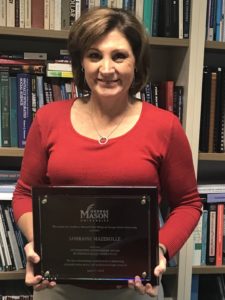Distinguished Achievement Award
Acceptance Remarks: Lorraine Mazerolle
2019 Recipient
The following are remarks by Lorraine Mazerolle, Professor of Criminology in the School of Social Science at the University of Queensland, upon receipt of the Distinguished Achievement Award in Evidence-Based Crime Policy. These remarks will also be featured in the Fall 2019 issue of Translational Criminology Magazine.

As with all field trials the planning and assembly of the resources to launch a trial of over 1000 young people is a huge undertaking. The police are prepped and ready. The schools are also eager to start. Nearly thirty years ago, I was in a similar situation, poised to hit the go button on a major field trial, working alongside David Weisburd when he led the Jersey City Drug Market Analysis Program Trial. In that trial, funded by the National Institute of Justice, we were equally all-consumed with the complexities of launching a complex field experiment. The Jersey City drug markets experiment was the first foray for the Jersey City Police into the world of experimentation. David and I worked tirelessly with the Narcotics officers to bring about that trial.
Jersey City in the early 1990s was quite a different place to what it is these days. In a relatively small geographic area, it was not hard for us to identify more than 50 open air drug markets that were stable markets from one year to the next. We didn’t think about it at the time, but I can see now that the experiments of the early 1990s, primarily led by David Weisburd and his long-time friend and colleague Lawrence Sherman, were ground breaking, pioneering endeavours.
The experiments were innovative in design, theoretically rich, and complex in all aspects of negotiating with our policing partners. For me, as a young PhD student, it was like being thrown into the deep part of a thunderous ocean: if you didn’t swim, you would sink. I learned so much as a student of David’s about the craft of building the evidence based.
I would also like to acknowledge the people who have gathered together for the 2019 Symposium. The topics being addressed in this year’s symposium are of critical importance, not just to policing in the United States, but across the globe, including in my home country of Australia.
We know, for example, that mentally ill people represent about a quarter of all arrested offenders in Australia. Police in Australia are overwhelmed with the resource implications for transporting mentally ill people to emergency rooms and they are constantly the first responders to a range of increasingly complex presentations.
In the area of traffic enforcement – my team at the University of Queensland just completed a rapid review from the Global Policing Database (see http://www.gpd.uq.edu.au ) of the evidence pertaining to road policing. We know from that review that there have been more than 300 quasi-experimental, randomized field trials and systematic reviews that inform the evidence base on road policing operations.
David Weisburd and his team are presenting on research exploring the role of collective efficacy and health in crime hotspots. Our research in Australia – specifically the Australian Community Capacity Study https://accs.project.uq.edu.au/ involving six waves of more than 10,000 residents in community surveys since 2006 — shows that policing agencies can be instrumental in encouraging collective efficacy when they foster a sense of effectiveness, and when they use inclusive and partnership-oriented strategies that encourage perceptions of police legitimacy.
The role of police in schools is another topic for the symposium and also a matter of great policy interest in Australia: in Queensland alone, the police spent $10 million every year funding police in schools. The results from our proof of concept trial called the Ability School Engagement Partnership Program – or ASEP for short – suggests that police investments would be best allocated in a manner that allows police to move across clusters of schools – perhaps servicing 8-10 schools at a time – working in partnership with the schools to directly engage with young people and their guardian to explain the truancy laws in a procedurally just manner and thereby harmonize a young person’s learning opportunities for legal socialization.
And finally, the session this morning on mass violence is a policing issue that challenges the entire world. The recent experiences in Christchurch, New Zealand are sobering. What we know, however, is that the legislation enacted in 1996 in Australia — that is often referred to as the Aussie gun buy-back program – had a significant and sustained impact on reducing gun related homicides and serious injury. This is the type of evidence that can save lives.
What is clear to me is that evidence based crime policy transcends jurisdictional boundaries: we build a global evidence base that can be translated and tested by police all over the world. I know that the work of the Center for Evidence Based Crime Policy is shaping much of the policy and practice not just in North America but also across the Southern parts of the globe. Of course not all interventions work in all countries. But many of them do.
So…thank you for bestowing on me the Distinguished Achievement Award from the Center for Evidence Based Crime Policy. I am sincerely grateful and honoured to accept this award.
